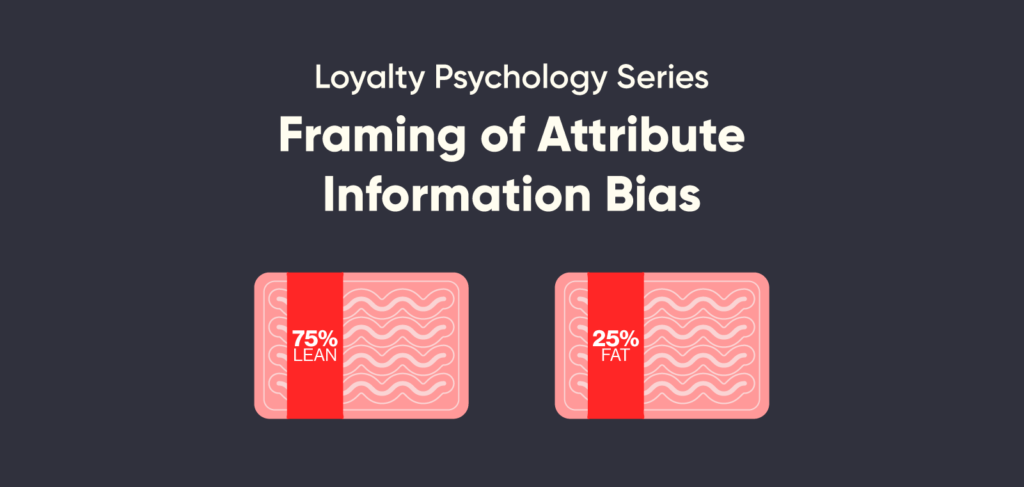
Levin and Gaeth asked subjects to rate several qualitative attributes of ground beef that framed the beef as either 75 per cent lean or 25 per cent fat. Subjects provided more favourable evaluations of the beef labelled 75 per cent lean.
Figure 11: the experiment run by Levin and Gaeth, showing the effects of framing of ground beef attributes on subjects. Adapted from ‘How Consumers Are Affected by the Framing of Attribute Information Before and After Consuming the Product’, Levin, I and Gaeth, G, 1988.194
Diamond and Campbell (1988) tested subjects in a laboratory simulation which compared monetary promotions (such as discounts) with non-monetary promotions (such as free goods or extra amounts of the product) using the same referenced price value. Subjects rated non-monetary promotions as making them feel that they are ‘gaining something extra’. In contrast, subjects rated monetary promotions as making them feel that they were ‘losing less than usual’.195 In short, non-monetary promotions were framed as gains and monetary promotions were framed as reduced losses, indicating non-monetary promotions are viewed more favourably.
This hypothesis was again tested in an experiment specifically involving supermarket coupons.196 The test demonstrated that supermarket shoppers presented with redeemable coupons were significantly more likely to choose a test promotion if it were framed as a gain (buy a spaghetti sauce and get a free soup valued at 49c) than if it were framed as a reduced loss (buy a spaghetti sauce and a soup and get 49c off the bill).
Framing provides important direction for communication positioning within a loyalty program. Program operators can utilise framing in a variety of ways:
- Position rewards as additional perks that are provided to loyal customers at the company’s expense (O’Malley and Prothero, 2002).197
- Use progress trackers, which highlight the progress made towards the completion of a goal and unlocking of a reward. Despite the need for a member to make further transactions, the progress tracker enables communications to be framed as a gain (e.g. earn just 200 points more to unlock a free flight) rather than a loss (e.g. $200 spend is required to unlock a free flight). The goal may be access to a reward product or the achievement of a status tier.
- Tailor messages to loyalty program members to emphasise their special status and acknowledge the importance of the relationship with the brand (Shugan, 2005).198
- Implement a points plus pay option as part of the standard purchase flow, allowing members to reduce the amount of cash they spend by subsidising the cost with points. Examples include airlines which allow members to reduce the total cost of the fare by paying with a combination of cash and frequent flyer points (a positive frame). Drèze & Nunes (2004)199 conducted research which delivered a mathematical proof that a combination of cash and points can be superior to a standard, single-currency price by lowering the psychological or perceived cost.
Returning to Levin and Gaeth’s study on lean vs fat beef, they reported that the magnitude of the framing effect lessened when subjects actually tasted the meat, suggesting a diagnostic product experience dilutes the impact of framing. This is an important consideration which cautions that while consumers may be influenced by framing, they will be influenced more by the actual experience of consumption. A focus on delivering a customer experience that is consistent with, or exceeds, expectations must be a priority in the pursuit of genuine member loyalty.
Dosh
Dosh200 is a card linked cashback program based in the US with over 1,000 affiliate partner stores and restaurants. Members can link their credit or debit card to the Dosh app, and when they make a purchase at a partner store with the linked credit card, ‘Dosh’ (a cashback percentage of the purchase) is automatically applied.
By magnifying the gain (cashback), rather than the loss (financial), Dosh are framing the program as positive (i.e. their website states it as ‘the easiest money you’ve ever made’).
Watching the Dosh add up on the cashback counter in the app over time, members are constantly presented with the positive effects of their amplified ‘gains’.

